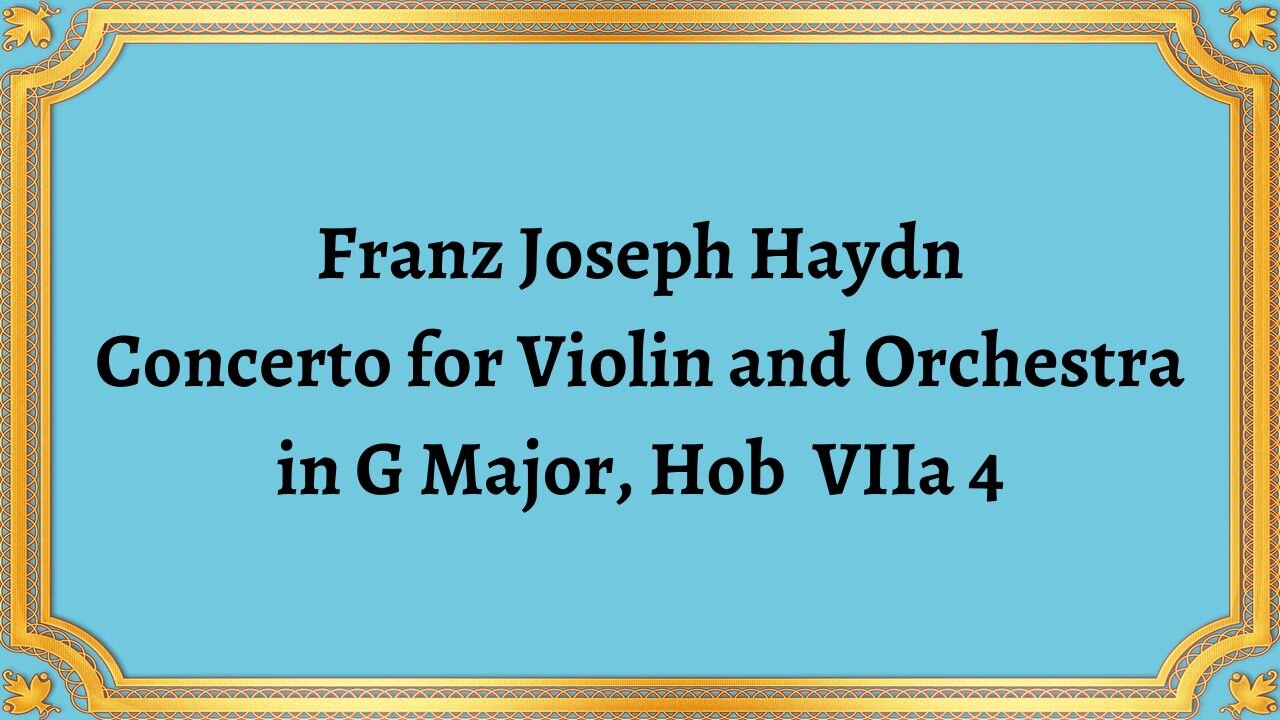Premium Only Content

Franz Joseph Haydn Concerto for Violin and Orchestra in G Major, Hob VIIa 4
#FranzJosephHaydn#ViolinConcerto#GMajor#HobVIIa4#ClassicalMusic#Orchestra#Soloist#Allegro#Adagio#TechnicalVirtuosity
Franz Joseph Haydn was one of the most important and prolific composers of the Classical era. His musical contributions to Western music spanned many forms, from operas to symphonies to chamber music. One of Haydn's most celebrated works is the Violin Concerto in G Major, Hob. VIIa:4, which was composed for the violinist Luigi Tomasini.
This remarkable concerto is composed of three movements - Allegro moderato, Adagio, and Allegro - and was written for a small orchestra. The piece is considered one of Haydn's most technically demanding works, requiring great skill and virtuosity from the solo violinist. It is characterized by its bright and cheerful melody, which is reprised in different keys and variations throughout the three movements.
The first movement, Allegro moderato, opens with a beautifully crafted orchestral introduction, after which the violinist enters, playing a technically demanding solo melody. What follows is a dialogue between the soloist and the orchestra, each playing off the other to create a stunning and complex musical tapestry.
The second movement, Adagio, is a beautiful and lyrical composition that allows the soloist to showcase their emotional range while exploring the depth and beauty of the melody. The Adagio is notable for its simplicity, which Haydn uses to great effect in bringing out the emotional intensity of the piece.
The final movement, Allegro, is a lively and energetic piece that demands great skill from the soloist. This cheerful and vibrant composition is characterized by its use of staccato rhythms, rapid scale passages, and unexpected dynamic turns, which create a sense of joy and excitement that carries the listener to the piece’s grand finale.
Overall, the Violin Concerto in G Major, Hob. VIIa:4 is an extraordinary piece of music that highlights Haydn's immense talent, his creative genius, and his mastery of the classical concerto form. The piece is marked by its technical virtuosity, its emotional depth, and its sophisticated composition, making it one of the greatest examples of Haydn's musical legacy.
In conclusion, the Violin Concerto in G Major is a testament to Haydn's ability to blend technical virtuosity with musical beauty seamlessly. Its lasting popularity speaks to its enduring musicality, and it remains a cherished masterpiece within the classical violin repertoire to this day.
You have the opportunity to support the channel https://destream.net/live/RadSiarAl/donate
-
 32:30
32:30
Classical music_Music Inspiration
1 month agoArturo Toscanini Grand Canyon Suite
781 -
 LIVE
LIVE
The Rubin Report
1 hour agoTrump Goes in Expletive-Filled Tirade Over Israel & Iran Messing Up Ceasefire Agreement
3,189 watching -
 1:00:54
1:00:54
VINCE
3 hours agoA New Middle East: Did Trump's Gambit Pay Off? | Episode 71 - 06/24/25
175K62 -
 LIVE
LIVE
Benny Johnson
1 hour agoFURIOUS Trump Drops F-BOMB on Live-TV | Rages at Israel, Iran For Attacks After Peace Deal: 'F***'🤬
8,571 watching -
 LIVE
LIVE
The Big Mig™
5 hours agoCEASEFIRE?….NOPE! Whats Next?
4,227 watching -
 LIVE
LIVE
LFA TV
14 hours agoLFA TV ALL DAY STREAM - TUESDAY 6/24/25
3,806 watching -
 40:24
40:24
Rethinking the Dollar
1 hour agoTrump Drops F‑Bomb on Ceasefire—Is WWIII Next? | Morning Check-In
6.31K7 -
 LIVE
LIVE
Bannons War Room
4 months agoWarRoom Live
17,591 watching -
 1:13:10
1:13:10
Dear America
3 hours agoPeace Through Strength WORKS But Will Ceasefire HOLD?! + What's Next For "MAGA" Frauds?!
101K150 -
 LIVE
LIVE
Akademiks
2 hours agoDiddy Trial Day 29: Approaching Closing Arguments. Prosecution Rests its Case. VERDICT INCOMING?1/30
1,923 watching